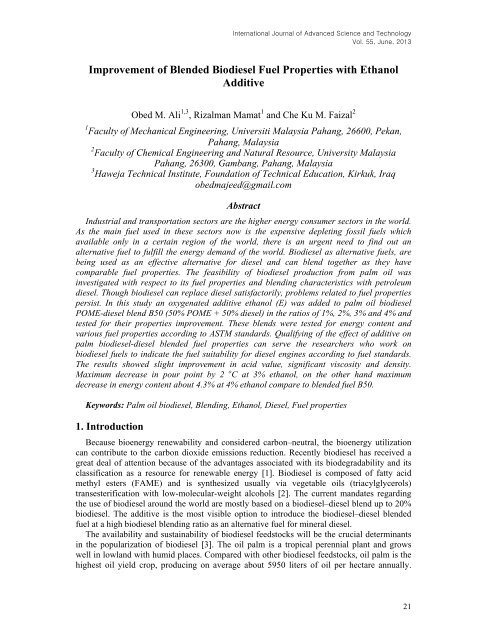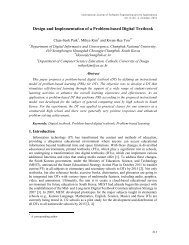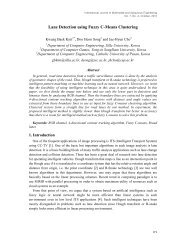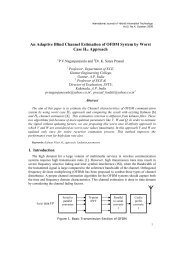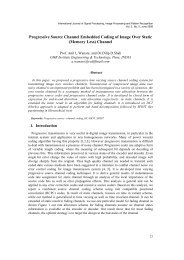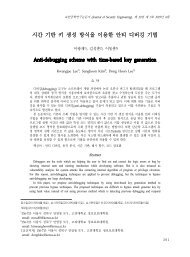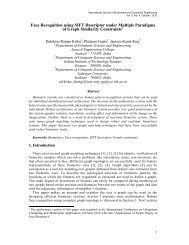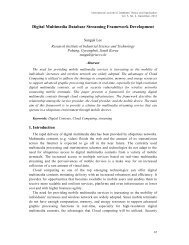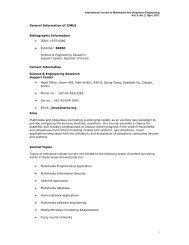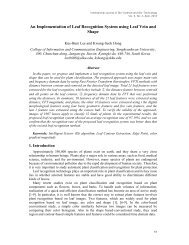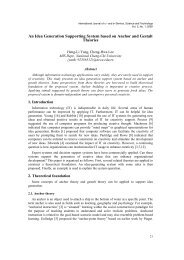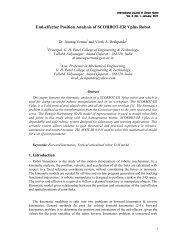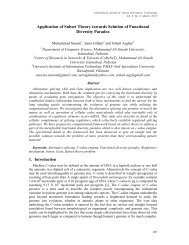Improvement of Blended Biodiesel Fuel Properties with Ethanol ...
Improvement of Blended Biodiesel Fuel Properties with Ethanol ...
Improvement of Blended Biodiesel Fuel Properties with Ethanol ...
You also want an ePaper? Increase the reach of your titles
YUMPU automatically turns print PDFs into web optimized ePapers that Google loves.
International Journal <strong>of</strong> Advanced Science and Technology<br />
Vol. 55, June, 2013<br />
<strong>Improvement</strong> <strong>of</strong> <strong>Blended</strong> <strong>Biodiesel</strong> <strong>Fuel</strong> <strong>Properties</strong> <strong>with</strong> <strong>Ethanol</strong><br />
Additive<br />
Obed M. Ali 1,3 , Rizalman Mamat 1 and Che Ku M. Faizal 2<br />
1 Faculty <strong>of</strong> Mechanical Engineering, Universiti Malaysia Pahang, 26600, Pekan,<br />
Pahang, Malaysia<br />
2 Faculty <strong>of</strong> Chemical Engineering and Natural Resource, University Malaysia<br />
Pahang, 26300, Gambang, Pahang, Malaysia<br />
3 Haweja Technical Institute, Foundation <strong>of</strong> Technical Education, Kirkuk, Iraq<br />
obedmajeed@gmail.com<br />
Abstract<br />
Industrial and transportation sectors are the higher energy consumer sectors in the world.<br />
As the main fuel used in these sectors now is the expensive depleting fossil fuels which<br />
available only in a certain region <strong>of</strong> the world, there is an urgent need to find out an<br />
alternative fuel to fulfill the energy demand <strong>of</strong> the world. <strong>Biodiesel</strong> as alternative fuels, are<br />
being used as an effective alternative for diesel and can blend together as they have<br />
comparable fuel properties. The feasibility <strong>of</strong> biodiesel production from palm oil was<br />
investigated <strong>with</strong> respect to its fuel properties and blending characteristics <strong>with</strong> petroleum<br />
diesel. Though biodiesel can replace diesel satisfactorily, problems related to fuel properties<br />
persist. In this study an oxygenated additive ethanol (E) was added to palm oil biodiesel<br />
POME-diesel blend B50 (50% POME + 50% diesel) in the ratios <strong>of</strong> 1%, 2%, 3% and 4% and<br />
tested for their properties improvement. These blends were tested for energy content and<br />
various fuel properties according to ASTM standards. Qualifying <strong>of</strong> the effect <strong>of</strong> additive on<br />
palm biodiesel-diesel blended fuel properties can serve the researchers who work on<br />
biodiesel fuels to indicate the fuel suitability for diesel engines according to fuel standards.<br />
The results showed slight improvement in acid value, significant viscosity and density.<br />
Maximum decrease in pour point by 2 o C at 3% ethanol, on the other hand maximum<br />
decrease in energy content about 4.3% at 4% ethanol compare to blended fuel B50.<br />
Keywords: Palm oil biodiesel, Blending, <strong>Ethanol</strong>, Diesel, <strong>Fuel</strong> properties<br />
1. Introduction<br />
Because bioenergy renewability and considered carbon–neutral, the bioenergy utilization<br />
can contribute to the carbon dioxide emissions reduction. Recently biodiesel has received a<br />
great deal <strong>of</strong> attention because <strong>of</strong> the advantages associated <strong>with</strong> its biodegradability and its<br />
classification as a resource for renewable energy [1]. <strong>Biodiesel</strong> is composed <strong>of</strong> fatty acid<br />
methyl esters (FAME) and is synthesized usually via vegetable oils (triacylglycerols)<br />
transesterification <strong>with</strong> low-molecular-weight alcohols [2]. The current mandates regarding<br />
the use <strong>of</strong> biodiesel around the world are mostly based on a biodiesel–diesel blend up to 20%<br />
biodiesel. The additive is the most visible option to introduce the biodiesel–diesel blended<br />
fuel at a high biodiesel blending ratio as an alternative fuel for mineral diesel.<br />
The availability and sustainability <strong>of</strong> biodiesel feedstocks will be the crucial determinants<br />
in the popularization <strong>of</strong> biodiesel [3]. The oil palm is a tropical perennial plant and grows<br />
well in lowland <strong>with</strong> humid places. Compared <strong>with</strong> other biodiesel feedstocks, oil palm is the<br />
highest oil yield crop, producing on average about 5950 liters <strong>of</strong> oil per hectare annually.<br />
21
International Journal <strong>of</strong> Advanced Science and Technology<br />
Vol. 55, June, 2013<br />
Sunflower, canola, soybean, and jatropha can only produce up to 952, 1190, 446, and 1892<br />
liters <strong>of</strong> oil per hectare annually, respectively [4]. From the literature, it has been found that<br />
feedstock alone represents 75%-80% <strong>of</strong> the overall biodiesel production cost [5–7].<br />
Therefore, selecting the high oil yield feedstock is vital to ensure low production cost <strong>of</strong><br />
biodiesel. <strong>Biodiesel</strong> (a mixture <strong>of</strong> mono-alkyl esters <strong>of</strong> saturated and unsaturated long-chain<br />
fatty acids) generally has a higher cloud and pour point (CP and PP), density, and kinematic<br />
viscosity as well as the acid value compared to diesel. The cold flow properties (CP and PP)<br />
are used to characterize the cold flow operability <strong>of</strong> a fuel because the pour point <strong>of</strong> a fuel<br />
affects the utility <strong>of</strong> the fuel, especially in cold climate conditions [8].<br />
<strong>Fuel</strong> injection systems measure fuel by volume, and thus, engine output power influence<br />
by changes in density due to the different injected fuel mass [9]. Thus, density is important<br />
for various diesel engine performance aspects. The use <strong>of</strong> fuel <strong>with</strong> a high kinematic viscosity<br />
can lead to undesired consequences, such as poor fuel atomization during spraying, engine<br />
deposits, wear on fuel pump elements and injectors, and additional energy required to pump<br />
the fuel [10, 11]. The fuel energy content has a direct influence on the engine power output<br />
[12, 13]. The biodiesel energy content is less than that <strong>of</strong> mineral diesel, therefore using <strong>of</strong><br />
additive most not worsen the energy continent <strong>of</strong> the POME fuel. Use <strong>of</strong> additive that have<br />
less energy continent <strong>with</strong> blended fuel usually causes the energy content <strong>of</strong> the fuel to<br />
decrease depending on the additive energy continent and portion. Currently, the energy<br />
content is one <strong>of</strong> the major technical issues in the use <strong>of</strong> biodiesel–diesel blends, as it relates<br />
to the engine power. The conducted researches on measuring the energy content very little<br />
and didn’t indicate the methods and equipment’s used for measurement. However,<br />
information concerning the energy content <strong>of</strong> palm oil biodiesel and its blending <strong>with</strong> additive<br />
remains scarce.<br />
The higher concentration <strong>of</strong> oxygen in biodiesel improves lubricity, combustion and<br />
reduces emissions while it slightly increases NOx. Low-level blends <strong>of</strong> ethanol can further<br />
reduce the emissions and can decrease viscosity [14]. However, drawbacks <strong>of</strong> E-diesel<br />
include reduced energy content [15], cetane number [16], flash point [16], lubricity [17] and<br />
immiscibility <strong>of</strong> ethanol in diesel [16, 18]. A recent study [17] explored the utility <strong>of</strong> ethanolbiodiesel-diesel<br />
blends (EB-diesel) as a means to mitigate the miscibility issues <strong>of</strong> E-diesel.<br />
The disadvantages <strong>of</strong> E-diesel were substantially reduced or eliminated in the case <strong>of</strong> EBdiesel<br />
prepared from 5% ethanol and 20% biodiesel (soybean oil methyl esters) in ultra low<br />
sulfur diesel (LSD) fuel [17]. A later study [19] revealed that 3% ethanol, 2% biodiesel<br />
(sunflower oil methyl esters), and 95% low sulfur diesel improved the pour point (PP) <strong>of</strong> the<br />
resultant blend. In general, EB-diesel blends resulted in reduced CO and HC exhaust<br />
emissions versus neat LSD. Also elucidated were the effects <strong>of</strong> blending ethanol <strong>with</strong><br />
biodiesel (E-biodiesel) in a 6:4 ratio on the PP, kinematic viscosity, and flash point (FP).<br />
Specifically, the PP <strong>of</strong> biodiesel was reduced from 3 o C to 9 o C, kinematic viscosity (40 o C)<br />
was reduced from 4.22 to 1.65mm2/s, and FP was reduced from 187 to 14 o C after blending<br />
<strong>with</strong> ethanol [19].<br />
Analogously, [20, 21] a blend <strong>of</strong> ethanol and biodiesel prepared from Madhuca indica oil<br />
(MME) and poultry fat (PFME) exhibited better fuel properties versus unblended biodiesel.<br />
Where the reduction in cloud point and pour point was 4 o C and 3 o C for MME and 6 o C and 4<br />
o C for PFME respectively, when blended <strong>with</strong> 20% <strong>of</strong> ethanol, <strong>with</strong> reduction in CO, lower<br />
NOx emissions and decrease in smoke emissions on an average <strong>with</strong>out affecting the thermal<br />
efficiency.<br />
Other experimental investigations [22, 23] were conducted to evaluate the effects <strong>of</strong> using<br />
ethanol as additives to soybean biodiesel/diesel blends on the performance, emissions and<br />
combustion characteristics <strong>of</strong> a direct injection diesel engine. The tested fuels denoted as<br />
22
International Journal <strong>of</strong> Advanced Science and Technology<br />
Vol. 55, June, 2013<br />
B20E5 (20% biodiesel and 80% diesel in vol.) <strong>with</strong> 5% ethanol and (B30E5) 30% biodiesel<br />
and 70% diesel in vol.) <strong>with</strong> 5% ethanol. The results indicate that, compared <strong>with</strong> blended<br />
fuel, there is a slightly lower brake specific fuel consumption (BSFC). Drastic reduction in<br />
smoke is observed <strong>with</strong> ethanol at higher engine loads. Nitrogen oxide (NOx) emissions and<br />
hydrocarbon (HC) emissions are slightly higher for blended fuel <strong>with</strong> ethanol, but carbon<br />
monoxide (CO) is slightly lower. However, the blended fuels <strong>with</strong> ethanol could lead to<br />
reduce both <strong>of</strong> NOx and HC emissions <strong>of</strong> a diesel engine [24], where biodiesel was blended<br />
<strong>with</strong> 5%, 10% and 15% by volume <strong>of</strong> ethanol and tested in a 4-cylinder direct-injection diesel<br />
engine.<br />
Palm biodiesel-diesel blends up to B40 can be directly used in diesel engines <strong>with</strong>out<br />
making any engine modifications [25]. Therefore, the first objective <strong>of</strong> the current study was<br />
to characterize the properties <strong>of</strong> the palm oil methyl esters (POME) and blended fuel B50,<br />
including the energy content and low temperature operability. The second objective was to<br />
improve the low temperature operability <strong>of</strong> blended fuel B50 through the addition <strong>of</strong> a small<br />
portion <strong>of</strong> ethanol additive. Of additional interest was a comparison <strong>of</strong> B50-E fuel properties<br />
at different additive portion to the ASTM D6751 [26] and EN 14214 [27], the American and<br />
European biodiesel standards, respectively. The low temperature operability <strong>of</strong> the resulting<br />
B50-E blends was ascertained through measurement <strong>of</strong> cloud point (CP) and pour point PP.<br />
Also <strong>of</strong> interest was the influence <strong>of</strong> ethanol addition on the kinematic viscosity (40 o C),<br />
density (15 o C), acid value (AV), and energy content <strong>of</strong> blended fuel B50.<br />
2. Materials and Method<br />
Palm oil biodiesel (POME) was supplied by local commercial company in Selangor,<br />
Malaysia. Diesel fuel was provided by a commercial fuel manufacturer. Samples <strong>of</strong> palm oil<br />
methyl ester and petroleum diesel were prepared as B50 (50%vol. POME + 50%vol. diesel)<br />
through mixed and blended using electrical magnetic stirrer shown in Figure 1(a). The<br />
mixtures were stirred continuously for 20 minutes. Then, ethanol (E) was added into the<br />
blended fuel at low stirring rate. The mixtures were stirred continuously for additional 20<br />
minutes and left for 30 minutes to reach equilibrium at room temperature before they were<br />
subjected to any test. The use <strong>of</strong> E has also some limitations, such as lower lubricity, reduced<br />
ignitability and cetane number, higher volatility and lower miscibility [28] which may lead to<br />
increased unburned hydrocarbons emissions. Therefore, E was added in small proportions <strong>of</strong><br />
1%, 2%, 3% and 4% by volume to blended fuel, which corresponded to B50-E1, B50-E2,<br />
B50-E3 and B50-E4 fuels, respectively.<br />
The acid value, cloud point, pour point, density, and kinematic viscosity were determined<br />
according to ASTM D-664, ASTM D-2500, ASTM D-97, ASTM D1298 and ASTM D-445,<br />
respectively. In addition, the heating value <strong>of</strong> blended fuel which not specified in the<br />
biodiesel standards ASTM D6751 and have a minimum value <strong>of</strong> 35 MJ/kg in EN 14214 was<br />
determined by Oxygen Bomb Calorimeter model 6772 (Parr instrument company, USA). In<br />
these calorimeter systems shown in Figure 1(b), the heat leak is precisely measured during the<br />
calorimetric pre-period. This evaluation results in an estimate <strong>of</strong> the effective, average<br />
temperature <strong>of</strong> the calorimeter surroundings.<br />
This temperature value is then used throughout the test interval to provide the calorimeter<br />
heat leak correction. It harnesses the computing power <strong>of</strong> the controller, <strong>with</strong> no additional<br />
hardware costs, to provide heat leak correction capability that is almost identical to the<br />
approach used when non-electronic thermometry and manual calorimetric techniques are<br />
employed.<br />
Cloud point is defined as the temperature at which a cloud <strong>of</strong> wax crystals first appears in a<br />
liquid form when the liquid is cooled under certain conditions. PP is defined as the lowest<br />
23
International Journal <strong>of</strong> Advanced Science and Technology<br />
Vol. 55, June, 2013<br />
temperature at which a liquid can flow; the PP apparatus and procedure adopted were<br />
according to the ASTM D 97 standard method. The test apparatus shown in Figure 1(c)<br />
manufactured by Koehler instrument company K46195 (USA) was used for the cloud and<br />
pour point measurements.<br />
Acid number or neutralization number is a measure <strong>of</strong> free fatty acids contained in a fresh<br />
fuel sample. Free fatty acids (FFAs) are the saturated or unsaturated monocarboxylic acids<br />
that occur naturally in fats, oils or greases but are not attached to glycerol backbones [29].<br />
Fatty acids vary in carbon chain length and in the number <strong>of</strong> unsaturated bonds (double<br />
bonds). Higher amount <strong>of</strong> free fatty acids leads to higher acid value [30]. Acid value is<br />
expressed as mg KOH required for neutralizing 1 g <strong>of</strong> FAME. Higher acid content can cause<br />
severe corrosion in the fuel supply system <strong>of</strong> an engine. The acid value is determined using<br />
the ASTM D664 and EN 14104. The test apparatus manufactured Metrohm 785 (USA)<br />
shown in Figure 1(d) was used to measure the acid value.<br />
Kinematic viscosity measurements were made <strong>with</strong> a Digital Constant Temperature<br />
kinematic viscosity bath shown in Figure 1(e), while the density is measured by using<br />
Portable Density/Gravity Meter shown in Figure 1(f). High viscosity leads to problem in<br />
pumping and spray characteristics (atomization and penetration, etc.). The inefficient mixing<br />
<strong>of</strong> oil <strong>with</strong> air contributes to incomplete combustion.<br />
(a) (b) (c)<br />
(d) (e) (f)<br />
Figure 1. Analytical Instruments used to Measure <strong>Fuel</strong> <strong>Properties</strong>; (a) Magnetic<br />
Stirrer, (b) Density Meter, (c) Viscosity Bath, (d) Acid Value & Acidity Tester, (e)<br />
Oxygen Bomb Calorimeter, (f) Cloud and Pour Point Measuring Equipment<br />
24
International Journal <strong>of</strong> Advanced Science and Technology<br />
Vol. 55, June, 2013<br />
3. Results and Discussions<br />
3.1. Analysis <strong>of</strong> <strong>Biodiesel</strong> <strong>Properties</strong><br />
The measured fuel properties <strong>of</strong> the POME and blended fuel B50 are listed in Table 1and<br />
compare to the biodiesel specifications, including in ASTM D6751 standard. The PP, CP,<br />
kinematic viscosity, density and acid value for B50 were significantly higher than those <strong>of</strong> the<br />
mineral diesel and lower than those <strong>of</strong> POME, while the heating value was lower than that <strong>of</strong><br />
mineral diesel and higher than that <strong>of</strong> POME. In general the blended fuel B50 presented<br />
satisfactory fuel properties that satisfied most biodiesel specifications. The PP value <strong>of</strong> B50<br />
was about 2 o C, a property that limited the beneficial use <strong>of</strong> this blended in cold climates [31],<br />
[32].<br />
The selection <strong>of</strong> additives for oxygenating the fuel depends on economic feasibility,<br />
toxicity, fuel blending property, additive solubility, flash point <strong>of</strong> the blend, the viscosity <strong>of</strong><br />
the blend, solubility <strong>of</strong> water in the resultant blend, and water partitioning <strong>of</strong> the additive [28].<br />
Based on the fuel blending properties, toxicity and economic feasibility ethanol was selected.<br />
There are a number <strong>of</strong> fuel properties that are essential to the proper operation <strong>of</strong> a diesel<br />
engine. <strong>Ethanol</strong> (E) was further added to B50 at different volumetric ratios (varied from 0%<br />
to 4% in steps <strong>of</strong> 1%) to study the variations in the CP, PP, density, heating value, acid value<br />
and kinematic viscosity <strong>of</strong> the B50-E blends.<br />
Table 1. <strong>Properties</strong> <strong>of</strong> POME Compared to the <strong>Biodiesel</strong> Specifications<br />
Property Unit POME B50 ASTM<br />
D6751<br />
Acid Value mg KOH/g 0.49 0.33 0.5 max<br />
Viscosity at 40 o C mm 2 /s 4.6116 4.0 1.9-6.0<br />
Density at 15 o C kg/m 3 880.8 863.4 880<br />
CP<br />
o C 14 4 ---<br />
PP<br />
o C 14 2 ---<br />
Heating Value MJ/kg 38.6 42.7 ----<br />
3.2. Cloud Point and Pour Point Results<br />
B50-E blends have improved low temperature operability compared to unblended B50<br />
since the freezing point <strong>of</strong> E (-114 o C) are substantially below the temperature at which<br />
biodiesel typically undergoes solidification.<br />
Addition <strong>of</strong> E to B50 slightly affected CP by 1 o C decrease, while increasing E content<br />
from 0 to 4% resulted in a non regular decline in PP. Figure 2 shows the variations <strong>of</strong> the PP<br />
for blended fuel B50 <strong>with</strong> the volumetric percentage <strong>of</strong> the E. The minimum value <strong>of</strong> PP for<br />
B50 was 0 o C at 3% E. The low-temperature property <strong>of</strong> biodiesel does not indicate in ASTM<br />
and EN standards as it related to climatic conditions.<br />
25
International Journal <strong>of</strong> Advanced Science and Technology<br />
Vol. 55, June, 2013<br />
Figure 2. Variation in PP <strong>with</strong> the Volumatric Percentage <strong>of</strong> DEE (vol.%) for<br />
POME<br />
3.3. Density Results<br />
The densities <strong>of</strong> B50-E blended fuel produced in this study are very close to each other and<br />
in the range <strong>of</strong> 860–863.4 kg/m3 for B50-E4 and B50 respectively. They are suitable for the<br />
ASTM and EN standards and slightly higher than those <strong>of</strong> the diesel fuel 847 kg/m 3 . Figure 3<br />
presents the variety <strong>of</strong> density values for B50 <strong>with</strong> E Portion. It is clear that the density <strong>of</strong> the<br />
fuel decreases <strong>with</strong> rising <strong>of</strong> E portion in the mixture. The density <strong>of</strong> the B50-E blend<br />
decreased linearly <strong>with</strong> a higher volumetric percentage <strong>of</strong> the E, indicating that the additivity<br />
for the volume. Excellent agreement between the measured and estimated values <strong>of</strong> the<br />
density <strong>of</strong> the B50-E blends at 15 o C is given by:<br />
Density (kg/m3) = -0.84x + 863.64 R² = 0.965 (1)<br />
Where x is the volumetric percentage <strong>of</strong> the ethanol (vol.%).<br />
Figure 3. Variation in Density <strong>with</strong> the Volumatric<br />
percentage <strong>of</strong> DEE (vol.%) for POME<br />
26
International Journal <strong>of</strong> Advanced Science and Technology<br />
Vol. 55, June, 2013<br />
These results are in agreement <strong>with</strong> a previous study [33] that determined blends <strong>of</strong><br />
microalgae oil biodiesel and its blends <strong>with</strong> petroleum diesel. The density <strong>of</strong> the B50-E<br />
blends can satisfy the specifications for diesel and biodiesel blends, listed in the standards.<br />
3.4. Viscosity Results<br />
The viscosities <strong>of</strong> blended fuel vary in the range <strong>of</strong> 3.6 and 4.0 mm2/s for B50-E4 and B50<br />
respectively. All B50-E blend, as well as B50, satisfied the kinematic viscosity specification<br />
contained in ASTM D6751. The viscosity <strong>of</strong> the blend increases as the E portion increases in<br />
the fuel mixture as observed from Figure 4. Similar to density, the kinematic viscosity <strong>of</strong> the<br />
B50-E blend decreased linearly <strong>with</strong> a higher volumetric percentage <strong>of</strong> the E. The kinematic<br />
viscosity at 40 o C can be described by Eq. (2) for the B50-E blends, <strong>with</strong> a linear relationship:<br />
Viscosity (mm2/s) = -0.101x + 4.0255 R² = 0.9856 (2)<br />
Where x is the volumetric percentage <strong>of</strong> the E (vol.%). Likewise density, the kinematic<br />
viscosity <strong>of</strong> the B50-E blends are in agreement <strong>with</strong> a previous study [33] that determined<br />
blends <strong>of</strong> microalgae oil biodiesel and its blends <strong>with</strong> petroleum diesel.<br />
The density and kinematic viscosity <strong>of</strong> the B50-E blends can satisfy the specifications for<br />
diesel and biodiesel blends, including ASTM D975, ASTM D7467 and EN 14213 for all the<br />
studied ethanol portions.<br />
Figure 4. Variation in Viscosity <strong>with</strong> the Volumatric Percentage <strong>of</strong> DEE (vol.%)<br />
for POME<br />
3.5. Acid Value<br />
Addition <strong>of</strong> E to the blended fuel B50 improved the acid value (AV) <strong>of</strong> the fuel,<br />
where slight reduction in AV was achieved by increasing E portion. The acid value is<br />
determined using the ASTM D664 and EN 14104. Both standards approved a maximum<br />
acid value for biodiesel <strong>of</strong> 0.50 mg KOH/g [34, 35]. Figure 5 shows acid value pr<strong>of</strong>ile<br />
<strong>of</strong> B50-E blends, the acid value decrease by approximately 3% at 4% E additive, by<br />
volume <strong>with</strong> a maximum acid value for B50 was 0.33 mg KOH/g. This was expected, as<br />
E will dilute the free fatty acids present in POME, resulting in a reduction in AV. The<br />
acid value <strong>of</strong> the B50-E blend satisfies the requirement <strong>of</strong> ASTM D6751-06 and EN<br />
14104 Standard for all blending ranges.<br />
27
International Journal <strong>of</strong> Advanced Science and Technology<br />
Vol. 55, June, 2013<br />
Figure 5. Variation in Acid Value <strong>with</strong> the Volumatric Percentage <strong>of</strong> POME<br />
(vol.%) for POME-diesel Blends<br />
3.6. Heating value<br />
Heating value, heat <strong>of</strong> combustion is the amount <strong>of</strong> heating energy released by the<br />
combustion <strong>of</strong> a unit value <strong>of</strong> fuels. One <strong>of</strong> the most important determinants <strong>of</strong> heating<br />
value is the moisture content <strong>of</strong> the feedstock oil [36]. The heating value is not<br />
specified in the biodiesel standards ASTM D6751 and EN 14214 but is prescribed in<br />
EN 14213 (biodiesel for heating purpose) <strong>with</strong> a minimum <strong>of</strong> 35 MJ/kg [29]. Figure 6<br />
shows that the heating value <strong>of</strong> the B50-E blend decreased slightly <strong>with</strong> increasing<br />
volumetric percentage <strong>of</strong> the E. A minimum heating value for B50-E4 was 40.9 MJ/kg,<br />
which is 4.3% less than the heating value <strong>of</strong> the blended fuel B50. The heating value <strong>of</strong><br />
the B50-E blend satisfies the requirement <strong>of</strong> EN 14213 Standard for all blending ranges.<br />
Figure 6. Variation in Heating Value <strong>with</strong> the Volumatric Percentage <strong>of</strong> POME<br />
(vol.%) for POME-diesel Blends<br />
28
International Journal <strong>of</strong> Advanced Science and Technology<br />
Vol. 55, June, 2013<br />
4. Conclusions<br />
The objective <strong>of</strong> this study was to characterize how the key fuel properties changed<br />
when ethanol was added to palm oil methyl esters-diesel blends B50. According to<br />
the experimental results; the density and kinematic viscosity <strong>of</strong> the B50-E blend<br />
significantly decreased <strong>with</strong> the increase <strong>of</strong> E concentration in the blended fuel and<br />
displayed satisfactory fuel properties for all blending ranges. Similarly, the acid value<br />
<strong>of</strong> B50-E blends slightly improved <strong>with</strong> increasing E content. Likewise, increasing E<br />
content in the blended fuel B50 resulted in a significant difference in low temperature<br />
performance, <strong>with</strong> a maximum decrease in pour point by 2 o C for B50-E3 compare to<br />
B50. On the other hand, there was a slight difference in the cloud point <strong>of</strong> the blends<br />
by 1 o C. In general, the heating value decreases slightly <strong>with</strong> increasing E portion in<br />
the blends. B-E4 has the minimum heating value 4.3% less than the heating value <strong>of</strong><br />
the blended fuel B50, which is still satisfying the limits <strong>of</strong> the EN 14213. Finally,<br />
B50-E blends exhibited slightly superior low temperature performance, acid value,<br />
viscosity and density <strong>with</strong> slight lower energy continent in comparison to B50 and<br />
may be suggested as suitable choice when considering biodiesel diesel blended fuel<br />
<strong>with</strong> additives.<br />
Acknowledgements<br />
The authors would like to acknowledge to University Malaysia Pahang for the financial<br />
support under MTUN-CoE Research Grand RDU121201.<br />
References<br />
[1] O. M. Ali, R. Mamat and C. K. M. Faizal, “Review <strong>of</strong> the effects <strong>of</strong> additives on biodiesel properties,<br />
performance and emission features”, J. Renewable Sustainable Energy, vol. 5, no. 1, (2013), 012701.<br />
[2] R. Mamat, “Performance and emission characteristics <strong>of</strong> an automotive diesel engine using biodiesel fuel<br />
<strong>with</strong> the influence <strong>of</strong> air intake variables”, University <strong>of</strong> Birmingham, UK, (2009).<br />
[3] O. M. Ali, R. Mamat and C. K. M. Faizal, “Palm biodiesel production, properties and fuel additives”,<br />
International Review <strong>of</strong> Mechanical Engineering, vol. 6, no. 7, (2012), pp. 1573-1580.<br />
[4] O. M. Ali and R. Mamat, “Improving Engine Performance And Low Temperature <strong>Properties</strong> Of <strong>Blended</strong><br />
Palm <strong>Biodiesel</strong> Using Additives . A review”, Applied Mechanics and Materials, vol. 315, (2013), pp. 68-72.<br />
[5] A. L. Ahmad, N. H. Mat Yasin, C. J. C. Derek and J. K. Lim, “Microalgae as a sustainable energy source for<br />
biodiesel production: a review”, Renew Sustain Energy Rev, vol. 15, no. 1, (2011), pp. 584-93.<br />
[6] A. S. Silitonga, A. E. Atabani, T. M. I. Mahlia, H. H. Masjuki, I. A. Badruddin and S. Mekhilef, “A review<br />
on prospect <strong>of</strong> Jatropha curcas for biodiesel in Indonesia”, Renew Sustain Energy Rev, vol. 15, (2011), pp.<br />
3733-56.<br />
[7] S. S. Ragit, S. K. Mohapatra, K. Kundu and P. Gill, “Optimization <strong>of</strong> neem methyl ester from<br />
transesterification process and fuel characterization as a diesel substitute”, Biomass Bioenergy, vol. 35, no. 3,<br />
(2011), pp. 1138-44.<br />
[8] A. Ulusik, “Advantages and disadvantages <strong>of</strong> biodiesels”, Energy Educ Sci Technol, vol. 28, no. 1, (2011),<br />
pp. 221-226.<br />
[9] N. P. Bahadur, D. G. B. Boocock and S. K. Konar, “Liquid hydrocarbons from catalytic pyrolysis <strong>of</strong> sewage<br />
sludge lipid and canola oil: evaluation <strong>of</strong> fuel properties”, Energy <strong>Fuel</strong>s, vol. 9, (1995), pp. 248-56.<br />
[10] E. Alptekin and M. Canakci, “Determination <strong>of</strong> the density and the viscosities <strong>of</strong> biodiesel–diesel fuel<br />
blends”, Renewable Energy, vol. 33, (2008), pp. 2623-30.<br />
[11] M. Satyanarayana and C. Muraleedharan, “<strong>Biodiesel</strong> Production from Vegetable Oils: A Comparative<br />
Optimization Study”, Journal <strong>of</strong> Biobased Materials and Bioenergy, vol. 3, no. 4, (2009), pp. 335-341.<br />
[12] A. Karmakar, S. Karmakar and S. Mukherjee, “<strong>Properties</strong> <strong>of</strong> various plants and animals feedstocks for<br />
biodiesel production”, Bioresour Technol, vol. 101, no. 19, (2010), pp. 7201-10.<br />
29
International Journal <strong>of</strong> Advanced Science and Technology<br />
Vol. 55, June, 2013<br />
[13] N. K. Sahoo, M. K. Naik, S. Pradhan, S. N. Naik and L. M. Das, “High Quality <strong>Biodiesel</strong> from Thevetia<br />
peruviana Juss: Physico-Chemical, Emission and <strong>Fuel</strong> Performance Characteristics”, Journal <strong>of</strong> Biobased<br />
Materials and Bioenergy, vol. 6, no. 3, (2012), pp. 269-275.<br />
[14] M. A. Fazal, A. S. M. A. Haseeb and H. H. Masjuki, “<strong>Biodiesel</strong> feasibility study: An evaluation <strong>of</strong> material<br />
compatibility; performance; emission and engine durability”, Renewable and Sustainable Energy Reviews,<br />
vol. 15, no. 2, (2011) February, pp. 1314-1324.<br />
[15] O. Can, I. Celikten, and N. Usta, “Effects <strong>of</strong> ethanol addition on performance and emissions <strong>of</strong> a<br />
turbocharged indirect injection diesel engine running at different injection pressures”, Energ Convers<br />
Manage, vol. 45, (2004), pp. 2429-40.<br />
[16] D. Li, H. Zhen, L. Xingcai, Z. Wu-gao and Y. Jiang-guang, “Physico-chemical properties <strong>of</strong> ethanolediesel<br />
blend fuel and its effect on performance and emissions <strong>of</strong> diesel engines”, Renewable Energy, vol. 30,<br />
(2005), pp. 967-76.<br />
[17] S. Fernando and M. Hanna, “Development <strong>of</strong> a novel bi<strong>of</strong>uel blend using ethanolebiodieselediesel<br />
microemulsions: EB-diesel.,” Energy <strong>Fuel</strong>s, vol. 18, (2004), pp. 1695-703.<br />
[18] P. Satge de Caro, Z. Mouloungui, G. Vaitilingom and J. C. Berge, “Interest <strong>of</strong> combining an additive <strong>with</strong><br />
dieseleethanol blends for use in diesel engines”, <strong>Fuel</strong>, vol. 80, (2001), pp. 565-74.<br />
[19] H. Rahimi, B. Ghobadian, T. Yusaf, G. Najafi and M. Khatamifar, “Diesterol: an environmental-friendly IC<br />
engine fuel”, Renewable Energy, vol. 34, (2009), pp. 335-42.<br />
[20] P. V Bhale, N. V Deshpande and B. S. Thombre, “Improving the low temperature properties <strong>of</strong> biodiesel<br />
fuel”, Renewable Energy, vol. 34, (2009), pp. 794-800.<br />
[21] H. Joshi, B. R. Moser, J. Toler, W. F. Smith and T. Walker, “Effects <strong>of</strong> blending alcohols <strong>with</strong> poultry fat<br />
methyl esters on cold flow properties”, Renewable Energy, vol. 35, (2010), pp. 2207-10.<br />
[22] D. H. Qi, H. Chen, L. M. Geng and Y. Z. Bian, “Effect <strong>of</strong> diethyl ether and ethanol additives on the<br />
combustion and emission characteristics <strong>of</strong> biodiesel-diesel blended fuel engine”, Renewable Energy, vol.<br />
36, (2011), pp. 1252-1258.<br />
[23] M. L. Randazzo and J. R. Sodré, “Exhaust emissions from a diesel powered vehicle fuelled by soybean<br />
biodiesel blends ( B3 – B20 ) <strong>with</strong> ethanol as an additive ( B20E2 – B20E5 )”, <strong>Fuel</strong>, vol. 90, (2011), pp. 98-<br />
103.<br />
[24] L. Zhu, C. S. Cheung, W. G. Zhang and Z. Huang, “Emissions characteristics <strong>of</strong> a diesel engine operating on<br />
biodiesel and biodiesel blended <strong>with</strong> ethanol and methanol”, Science <strong>of</strong> the Total Environment, vol. 408, no.<br />
4, (2010), pp. 914-921.<br />
[25] P. K. S. Yadav, O. Singh and R. P. Singh, “Performance test <strong>of</strong> palm fatty acid biodiesel on compression<br />
ignition engine”, Journal <strong>of</strong> Petroleum Technology and Alternative <strong>Fuel</strong>s, vol. 1, no. 1, (2010), pp. 1-9.<br />
[26] American Society for Testing and Materials, “ASTM Standard D 6751-08: standard specification for<br />
biodiesel fuel blend stock (B100) for middle distillate fuels. West Conshohocken, PA (USA): 2008”, (2008).<br />
[27] B. (Belgium), “European Committee for Standardization; EN 14214: automotive fuels efatty acid methyl<br />
esters (FAME) for diesel engineserequirement methods”, (2003).<br />
[28] C. Swaminathan and J. Sarangan, “Performance and exhaust emission characteristics <strong>of</strong> a CI engine fueled<br />
<strong>with</strong> biodiesel (fish oil) <strong>with</strong> DEE as additive”, biomass and bioenergy., vol. 39, (2012), pp. 168-174.<br />
[29] U. Rashid, F. Anwar and G. Knothe, “Evaluation <strong>of</strong> biodiesel obtained from cotton-seed oil”, <strong>Fuel</strong> Process<br />
Technol, vol. 90, no. 9, (2009), pp. 1157-63.<br />
[30] H. T. Akcay and S. Karslioglu, “Optimization process for biodiesel production from some Turkish vegetable<br />
oils and determination fuel properties”, Energy Educ Sci Technol, vol. 28, no. 2, (2012), pp. 861-868.<br />
[31] T. Haiying, O. Steven, K. Y. Salley and S. N., “<strong>Fuel</strong> properties and precipitate formation at low temperature<br />
in soy-, cottonseed-, and poultry fat-based biodiesel blends”, <strong>Fuel</strong>, vol. 87, (2008), pp. 3006-3017.<br />
[32] C. Chuang-Wei, G. S. Leon and J. S. Galen, “Impact <strong>of</strong> cold flow improvers on soybean biodiesel blend”,<br />
Biomass and Bioenergy, vol. 27, (2004), pp. 485-491.<br />
[33] Y.-H. Chen, B.-Y. Huang, T.-H. Chiang and T.-C. Tang, “<strong>Fuel</strong> properties <strong>of</strong> microalgae (Chlorella<br />
protothecoides) oil biodiesel and its blends <strong>with</strong> petroleum diesel”, <strong>Fuel</strong>, vol. 94, (2012) April, pp. 270-273.<br />
[34] P. C. Jena, H. Raheman, G. V. P. Kumar and R. Machavaram, “<strong>Biodiesel</strong> production from mixture <strong>of</strong> mahua<br />
and simarouba oils <strong>with</strong> high free fatty acids”, Biomass Bioenergy, vol. 34, no. 8, (2010), pp. 1108-16.<br />
[35] Y. C. Sharma and B. Singh, “Development <strong>of</strong> biodiesel: current scenario”, Renew Sustain Energy Rev, vol.<br />
13, no. 6-7, (2009), pp. 1646-51.<br />
[36] A. Filemon, Bi<strong>of</strong>uels from plant oils. Jakarta, Indonesia, ASEAN Foundation, (2010), pp. 47.<br />
30
International Journal <strong>of</strong> Advanced Science and Technology<br />
Vol. 55, June, 2013<br />
Authors<br />
Obed M. Ali is a PhD. student - Universiti Malaysia Pahang. He was<br />
graduated his Master degree in Mechanical Engineering from University<br />
<strong>of</strong> Mosul - Iraq.<br />
Rizalman Mamat, Assoc. Pr<strong>of</strong>. Dr. Rizalman Bin Mamat is a<br />
lecturer at Universiti Malaysia Pahang. He was graduated his Doctor <strong>of</strong><br />
Philosophy at United Kingdom.<br />
Che Ku Mohammed Faizal, is a lecturer at Universiti Malaysia<br />
Pahang. He was graduated his Doctor <strong>of</strong> Philosophy at Japan.<br />
31
International Journal <strong>of</strong> Advanced Science and Technology<br />
Vol. 55, June, 2013<br />
32


